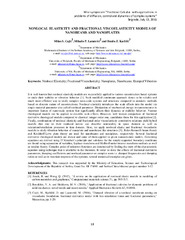Приказ основних података о документу
Nonlocal elasticity and fractional viscoelasticity models of nanobeams and nanoplates
| dc.creator | Cajić, Milan | |
| dc.creator | Lazarević, Mihailo | |
| dc.creator | Karličić, Danilo | |
| dc.date.accessioned | 2023-03-20T09:11:45Z | |
| dc.date.available | 2023-03-20T09:11:45Z | |
| dc.date.issued | 2016 | |
| dc.identifier.isbn | 978-86-7746-613-8 | |
| dc.identifier.uri | https://machinery.mas.bg.ac.rs/handle/123456789/6568 | |
| dc.description.abstract | It is well known that nonlocal elasticity models are successfully applied to various nanostructure based systems to study their stability or vibration behavior [1]. Such modified continuum approach shows to be reliable and much more efficient way to study complex nano-scale systems and structures compared to atomistic methods based on discrete nature of nanostructures. Nonlocal elasticity introduces the scale effects into the model via single material parameter also called nonlocal parameter. Dissipation of mechanical energy in nanostructures is important feature of nano-scale system that significantly affects their dynamic or stability behavior. Various rheological models can be applied to describe such effects. However, well known comparison of fractional derivative rheological models compared to classical integer order one, candidates them for this application [2]. Finally, combination of nonlocal elasticity and fractional order viscoelasticity constitutive relations yield hybrid models that due to their nonlocal nature can describe nonlocality in space domain as well as relaxation/retardation processes in time domain. Here, we apply nonlocal elastic and fractional viscoelastic models to study vibration behavior of nanoplate and nanobeam like structures [3]. Euler-Bernoulli beam theory and Kirchhoff-Love plate theory are used for nanobeams and nanoplates, respectively. Several fractional derivative rheological models are shown and some of them applied to given nanostructure models. Governing equations are derived using D’Alambert’s principle and solutions for the simply supported boundary conditions are found using separation of variables, Laplace transform and Mellin-Fourier inverse transform methods as well as residue theory. Complex poles of unknown functions are determined by finding the roots of the characteristic equation using technique that is available in the literature. In order to show the effects of fractional derivative parameters, damping coefficients and nonlocal parameter on complex roots i.e. damped frequencies and damping ratios as well as on transient response of the systems, several numerical examples are given. | sr |
| dc.language.iso | en | sr |
| dc.publisher | Faculty of Mechanical Engineering, Belgrade | sr |
| dc.publisher | University of Belgrade Mathematical Institute, Serbian Academy of Sciences and Arts | sr |
| dc.relation | Serbia-China bilateral project number 3-12 | sr |
| dc.relation | info:eu-repo/grantAgreement/MESTD/Basic Research (BR or ON)/174001/RS// | sr |
| dc.rights | openAccess | sr |
| dc.rights.uri | https://creativecommons.org/licenses/by/4.0/ | |
| dc.source | Booklet of Abstracts Mini-symposium “ Fractional Calculus with applications in problems of diffusion, control and dynamics of complex systems”, July 13, 2016 | sr |
| dc.subject | Nonlocal Elasticity | sr |
| dc.subject | Fractional Viscoelasticity | sr |
| dc.subject | Nanoplates | sr |
| dc.subject | Nanobeams | sr |
| dc.subject | Damped Vibration | sr |
| dc.title | Nonlocal elasticity and fractional viscoelasticity models of nanobeams and nanoplates | sr |
| dc.type | conferenceObject | sr |
| dc.rights.license | BY | sr |
| dc.citation.epage | 18 | |
| dc.citation.rank | M34 | |
| dc.citation.spage | 18 | |
| dc.identifier.fulltext | http://machinery.mas.bg.ac.rs/bitstream/id/16574/Cajic2016__MInisimp.pdf | |
| dc.identifier.rcub | https://hdl.handle.net/21.15107/rcub_machinery_6568 | |
| dc.type.version | publishedVersion | sr |


